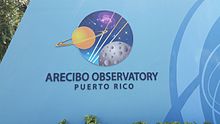
A primary mirror is the principal light-gathering surface of a reflecting telescope.

A radio telescope is a specialized antenna and radio receiver used to detect radio waves from astronomical radio sources in the sky. Radio telescopes are the main observing instrument used in radio astronomy, which studies the radio frequency portion of the electromagnetic spectrum emitted by astronomical objects, just as optical telescopes are the main observing instrument used in traditional optical astronomy which studies the light wave portion of the spectrum coming from astronomical objects. Unlike optical telescopes, radio telescopes can be used in the daytime as well as at night.
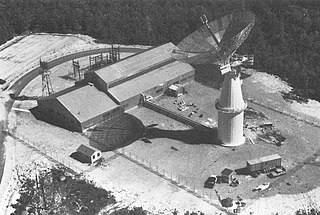
Radar astronomy is a technique of observing nearby astronomical objects by reflecting radio waves or microwaves off target objects and analyzing their reflections. Radar astronomy differs from radio astronomy in that the latter is a passive observation and the former an active one. Radar systems have been conducted for six decades applied to a wide range of Solar System studies. The radar transmission may either be pulsed or continuous. The strength of the radar return signal is proportional to the inverse fourth-power of the distance. Upgraded facilities, increased transceiver power, and improved apparatus have increased observational opportunities.

The Robert C. Byrd Green Bank Telescope (GBT) in Green Bank, West Virginia, US is the world's largest fully steerable radio telescope, surpassing the Effelsberg 100-m Radio Telescope in Germany. The Green Bank site was part of the National Radio Astronomy Observatory (NRAO) until September 30, 2016. Since October 1, 2016, the telescope has been operated by the independent Green Bank Observatory. The telescope's name honors the late Senator Robert C. Byrd who represented West Virginia and who pushed the funding of the telescope through Congress.
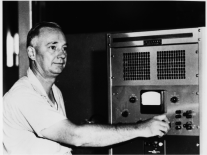
Grote Reber was an American pioneer of radio astronomy, which combined his interests in amateur radio and amateur astronomy. He was instrumental in investigating and extending Karl Jansky's pioneering work and conducted the first sky survey in the radio frequencies.

The Very Long Baseline Array (VLBA) is a system of ten radio telescopes which are operated remotely from their Array Operations Center located in Socorro, New Mexico, as a part of the National Radio Astronomy Observatory (NRAO). These ten radio antennas work together as an array that forms the longest system in the world that uses very long baseline interferometry. The longest baseline available in this interferometer is about 8,611 kilometers (5,351 mi).
The Joint Institute for Very Long Baseline Interferometry European Research Infrastructure Consortium (JIVE) was established by a decision of the European Commission in December 2014, and assumed the activities and responsibilities of the JIVE foundation, which was established in December 1993. JIVE's mandate is to support the operations and users of the European VLBI Network (EVN), in the widest sense.

William Edwin Gordon was an electrical engineer, physicist and astronomer. He was referred to as the "father of the Arecibo Observatory".

Sixto A. González Edick was the Director of the Arecibo Observatory from September 29, 2003, to September 15, 2006. Arecibo Observatory was an astronomical observatory located in Puerto Rico. At the time of González's directorship Arecibo was the world's largest single dish radio telescope. González was the first Puerto Rican in the position of Director of the observatory.

The Coquí and Coquí II campaign involved a sequence of sounding rocket launches in order to study the dynamics of the E- and F-region ionosphere and increase scientists' understanding of layering phenomena, such as sporadic E layers. The studies were supported by the United States' National Aeronautics and Space Administration (NASA) and carried out in 1992 and 1998 respectively.
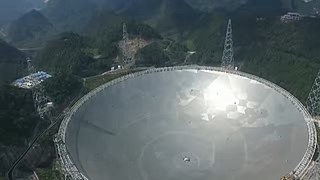
The Five-hundred-meter Aperture Spherical Telescope, nicknamed Tianyan, is a radio telescope located in the Dawodang depression (大窝凼洼地), a natural basin in Pingtang County, Guizhou, southwest China. FAST has a 500 m (1,600 ft) diameter dish constructed in a natural depression in the landscape. It is the world's largest filled-aperture radio telescope and the second-largest single-dish aperture, after the sparsely-filled RATAN-600 in Russia.

The Arecibo Telescope was a 305 m (1,000 ft) spherical reflector radio telescope built into a natural sinkhole at the Arecibo Observatory located near Arecibo, Puerto Rico. A cable-mount steerable receiver and several radar transmitters for emitting signals were mounted 150 m (492 ft) above the dish. Completed in November 1963, the Arecibo Telescope was the world's largest single-aperture telescope for 53 years, until it was surpassed in July 2016 by the Five-hundred-meter Aperture Spherical Telescope (FAST) in Guizhou, China.

Tor Hagfors was a Norwegian scientist, radio astronomer, radar expert and a pioneer in the studies of the interactions between electromagnetic waves and plasma. In the early 1960s he was one of a handful of pioneering theorists that independently developed a theory that explained the scattering of radio waves by the free electrons in a plasma and applied the result to the ionosphere. He became founding director of the new EISCAT facilities that were then under construction in 1975, by which time he already been director at most of the other incoherent scatter radar facilities in the world. The asteroid 1985 VD1 is named 7279 Hagfors after him.
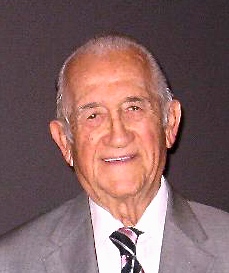
Helias Doundoulakis was a Greek American civil engineer who patented the suspension system for the at-the-time largest radio telescope in the world. During WWII he served in the United States Army and the Office of Strategic Services (OSS) as a spy.
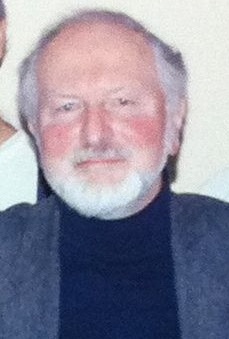
Riccardo Giovanelli was an Italian-born American astronomer. He was an emeritus professor of astronomy at Cornell University in Ithaca, New York, United States.

The Florida Space Institute (FSI) is a research institute of the State University System of Florida and the University of Central Florida located in Orlando, Florida, United States.

Joan T. Schmelz is the Associate Director for Science and Public Outreach at the Stratospheric Observatory for Infrared Astronomy (SOFIA) for the Universities Space Research Association (USRA). Previously, Schmelz was the Deputy Director of Arecibo Observatory and the Director of USRA Operations at Arecibo from 2015 through 2018. Before joining USRA, Schmelz was an NSF Program Director in the Astronomical Sciences Division, where she oversaw the Astronomy & Astrophysics Postdoctoral Fellowship program, and a professor of physics at the University of Memphis from 1996 to 2017. Schmelz's research focus is heliophysics, specifically investigating the coronal heating problem as well as the properties and dynamics of the solar atmosphere. She uses spectroscopic and image data in the X-ray and ultraviolet wavelength ranges obtained from NASA satellites and rockets. She has published over 80 refereed scientific journal articles and authored three books.
George James Doundoulakis was a Greek American physicist and soldier who worked under British Intelligence during World War II with SOE agent Patrick Leigh Fermor, and then served with the OSS in Thessaly, Greece.

Yervant Terzian was an American astronomer. He was the Tisch Distinguished Professor Emeritus in Cornell University's Department of Astronomy, which he chaired between 1979 and 1999.



